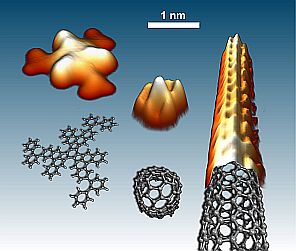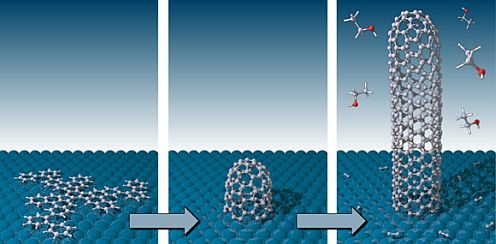How to synthesize structurally pure carbon nanotubes using molecular ‘seeds’
August 11, 2014

Scanning tunneling microscopy images of the precursor, the folded end cap, and the resulting carbon nanotube, together with the corresponding structural models (credit: Empa/Juan Ramon Sanchez Valencia)
Researchers at Empa and the Max Planck Institute for Solid State Research have succeeded in “growing” single-wall carbon nanotubes (SWCNTs) with a single predefined structure, with identical electronic properties.
The CNTs self-assembled out of tailor-made organic precursor molecules on a platinum surface, as reported by the researchers in the journal Nature.
With a diameter of roughly one nanometer, SWCNTs should be considered as quantum structures; the slightest structural changes, such as differences in diameter or in the alignment of the atomic lattice, may result in dramatic changes in electronic properties.
One SWCNT may be metallic, while another one with a slightly different structure is a semiconductor. So there is a great deal of interest in reliable methods of making SWCNTs as structurally uniform as possible. Such CNTs could help create next-generation electronic and electro-optical components that are smaller than ever before, allowing for faster switching times.

On a Platinum surface, the planar hydrocarbon precursor folds into an end cap, which in turn acts as a seed for the growth of a well-defined carbon nanotube. (Credit: Empa/Juan Ramon Sanchez Valencia)
How to create uniform carbon nanotubes
Here’s how the researchers did it:
- Transform the flat (2D) starting molecule into a three-dimensional object, the “germling.” This takes place on a hot platinum surface using a catalytic reaction in which hydrogen atoms are split off and new carbon-carbon bonds are formed at very specific locations. The “germ” — a small, dome-like entity with an open edge that sits on the platinum surface — is “folded” out of the flat molecule. This “end cap” forms the “lid” of the growing SWCNT.
- Attach more carbon atoms, which originate from the catalytic decomposition of ethylene (C2H4) on the platinum surface. They position themselves on the open edge between the platinum surface and the end cap, and raise the cap higher and higher, causing the nanotube to grow slowly upwards.
Only the germ defines the nanotube’s atomic structure, as the researchers were able to demonstrate through the analysis of the vibration modes of the SWCNTs and scanning tunnel microscope (STM) measurements. Further investigations using the new scanning helium ion microscope (SHIM) at Empa show that the resulting SWCNTs reach lengths greater than 300 nanometers.
The SWCNTs synthesized in this study are mirror-image symmetrical entities. However, depending on the manner in which the honeycombed atomic lattice is derived from the starting molecule (“straight” or “oblique” in relation to the CNT axis), it would also possible be possible to produce helically wound nanotubes, i.e., nanotubes twisting to the right or left, which are not mirror-image symmetrical.
This structure also determines the electronic, thermoelectric, and optical properties of the material. So in principle, the researchers could produce materials with different properties in a targeted manner by selecting the starting molecule.
The project was supported by the Swiss National Science Foundation (FNSNF).
Abstract of Nature paper
Over the past two decades, single-walled carbon nanotubes (SWCNTs) have received much attention because their extraordinary properties are promising for numerous applications. Many of these properties depend sensitively on SWCNT structure, which is characterized by the chiral index (n,m) that denotes the length and orientation of the circumferential vector in the hexagonal carbon lattice. Electronic properties are particularly strongly affected, with subtle structural changes switching tubes from metallic to semiconducting with various bandgaps. Monodisperse ‘single-chirality’ (that is, with a single (n,m) index) SWCNTs are thus needed to fully exploit their technological potential. Controlled synthesis through catalyst engineering, end-cap engineering or cloning strategies, and also tube sorting based on chromatography, density-gradient centrifugation, electrophoresis and other techniques, have delivered SWCNT samples with narrow distributions of tube diameter and a large fraction of a predetermined tube type. But an effective pathway to truly monodisperse SWCNTs remains elusive. The use of template molecules to unambiguously dictate the diameter and chirality of the resulting nanotube holds great promise in this regard, but has hitherto had only limited practical success. Here we show that this bottom-up strategy can produce targeted nanotubes: we convert molecular precursors into ultrashort singly capped (6,6) ‘armchair’ nanotube seeds using surface-catalysed cyclodehydrogenation on a platinum (111) surface, and then elongate these during a subsequent growth phase to produce single-chirality and essentially defect-free SWCNTs with lengths up to a few hundred nanometres. We expect that our on-surface synthesis approach will provide a route to nanotube-based materials with highly optimized properties for applications such as light detectors, photovoltaics, field-effect transistors and sensors.
